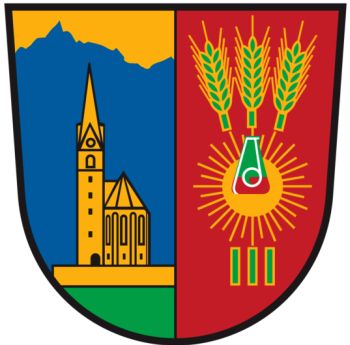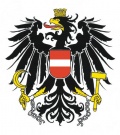Heiligenblut (Kärnten): Difference between revisions
Knorrepoes (talk | contribs) m (Text replace - "|}<seo title="Wappen von Österreich" />" to "|}<seo title="|}<seo title="Wappen, Gemeindewappen, Stadtwappen, Marktwappen, Österreich" />" />") |
Knorrepoes (talk | contribs) m (Text replacement - " :" to ":") Tags: Mobile edit Mobile web edit |
||
| (21 intermediate revisions by the same user not shown) | |||
| Line 1: | Line 1: | ||
'''HEILIGENBLUT''' | |||
State: [[Kärnten]]<br> | |||
District: Spittal an der Drau<br> | |||
[[File:heiligenblut.jpg|center|alt=Wappen von {{PAGENAME}}/Arms (crest) of {{PAGENAME}}]] | |||
===Official blazon=== | |||
Gespaltener Schild; vorn in Gold über grünem Schildfuß ein blauer Berg (Form des Großglockners) und eine goldene, spitztürmige Kirche (Form der Kirche von Heiligenblut), hinten in Rot drei grüne, golden gefasste Ähren von einem goldenen Nimbus überlegt, von dessen Mitte ein breitgedrücktes grünes Fläschchen mit roter Flüssigkeit (Reliquie vom heiligen Blut) in den Strahlenkranz ragt. | |||
===Origin/meaning=== | |||
The arms were officially granted on December 9, 1965. | |||
The arms show in the right half the local church and the mountains of the Grossglockner range. | |||
The left half is based on the Legend of Briccius. According to the legend, the Danish prince Briccius (Latin for Frederic) was killed in 914 on the site of today's Bricciuskapelle (chapel) when attempting to cross the Alps by an avalanche. He carried with him an ampoule with the Holy blood of Jesus Christ, which was said to have flowed from a portrait of the Crucified in the St. Sophia Church of Constantinople. Farmers found three green ears of wheat at Christmas 914 at the present Briccius Chapel in the middle of the snow. They then discovered the corpse of the prince and the vial of blood that has since been kept in the church of Heiligenblut (which also means Holy Blood). | |||
There is no evidence that Saint Briccius really lived. The name is however the Latin version of Frederic, a common name of Danish Princes, however, many centuries after the legend supposedly took place. It was also the name of several bishops of Salzburg in the High Middle Ages, who had possessions in the upper Mölltal where the town is situated. Probably the Briccius legend dates from the 13th century, which fits with the introduction of the Transubstantiation doctrine and the feast of Corpus Christi. In the 13th century many alleged blood-Christ relics pile up. | |||
The sun symbolises that Kärnten is the sunniest State of Austria. | |||
{{at}} | |||
{{media}} | |||
[[Literature]] : Deuer, 2006 | [[Civic Heraldry Literature - Austria|Literature]]: Deuer, 2006 | ||
[[Category:Austrian Municipalities H]] | [[Category:Austrian Municipalities H]] | ||
Latest revision as of 11:27, 11 August 2024
HEILIGENBLUT
State: Kärnten
District: Spittal an der Drau
Official blazon
Gespaltener Schild; vorn in Gold über grünem Schildfuß ein blauer Berg (Form des Großglockners) und eine goldene, spitztürmige Kirche (Form der Kirche von Heiligenblut), hinten in Rot drei grüne, golden gefasste Ähren von einem goldenen Nimbus überlegt, von dessen Mitte ein breitgedrücktes grünes Fläschchen mit roter Flüssigkeit (Reliquie vom heiligen Blut) in den Strahlenkranz ragt.
Origin/meaning
The arms were officially granted on December 9, 1965.
The arms show in the right half the local church and the mountains of the Grossglockner range.
The left half is based on the Legend of Briccius. According to the legend, the Danish prince Briccius (Latin for Frederic) was killed in 914 on the site of today's Bricciuskapelle (chapel) when attempting to cross the Alps by an avalanche. He carried with him an ampoule with the Holy blood of Jesus Christ, which was said to have flowed from a portrait of the Crucified in the St. Sophia Church of Constantinople. Farmers found three green ears of wheat at Christmas 914 at the present Briccius Chapel in the middle of the snow. They then discovered the corpse of the prince and the vial of blood that has since been kept in the church of Heiligenblut (which also means Holy Blood).
There is no evidence that Saint Briccius really lived. The name is however the Latin version of Frederic, a common name of Danish Princes, however, many centuries after the legend supposedly took place. It was also the name of several bishops of Salzburg in the High Middle Ages, who had possessions in the upper Mölltal where the town is situated. Probably the Briccius legend dates from the 13th century, which fits with the introduction of the Transubstantiation doctrine and the feast of Corpus Christi. In the 13th century many alleged blood-Christ relics pile up.
The sun symbolises that Kärnten is the sunniest State of Austria.
Austria heraldry portal
This page is part of the Austria heraldry portal |
Heraldry of the World |
|
Civic heraldry:
|
Other heraldry: |
Contact and Support
Partners:
Your logo here ?
Contact us
© since 1995, Heraldry of the World, Ralf Hartemink 
Index of the site
Literature: Deuer, 2006












